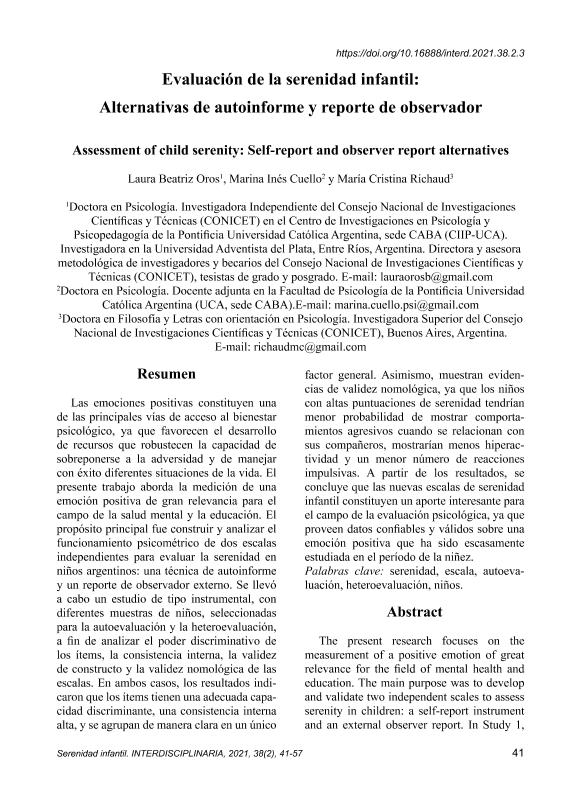Artículo
Las emociones positivas constituyen una de las principales vías de acceso al bienestar psicológico, ya que favorecen el desarrollo de recursos que robustecen la capacidad de sobreponerse a la adversidad y de manejar con éxito diferentes situaciones de la vida. El presente trabajo aborda la medición de una emoción positiva de gran relevancia para el campo de la salud mental y la educación. El propósito principal fue construir y analizar el funcionamiento psicométrico de dos escalas independientes para evaluar la serenidad en niños argentinos: una técnica de autoinforme y un reporte de observador externo. Se llevó a cabo un estudio de tipo instrumental, con diferentes muestras de niños, seleccionadas para la autoevaluación y la heteroevaluación, a fin de analizar el poder discriminativo de los ítems, la consistencia interna, la validez de constructo y la validez nomológica de las escalas. En ambos casos, los resultados indicaron que los ítems tienen una adecuada capacidad discriminante, una consistencia interna alta, y se agrupan de manera clara en un único factor general. Asimismo, muestran evidencias de validez nomológica, ya que los niños con altas puntuaciones de serenidad tendrían menor probabilidad de mostrar comportamientos agresivos cuando se relacionan con sus compañeros, mostrarían menos hiperactividad y un menor número de reacciones impulsivas. A partir de los resultados, se concluye que las nuevas escalas de serenidad infantil constituyen un aporte interesante para el campo de la evaluación psicológica, ya que proveen datos confiables y válidos sobre una emoción positiva que ha sido escasamente estudiada en el período de la niñez. The present research focuses on the measurement of a positive emotion of great relevance for the field of mental health and education. The main purpose was to develop and validate two independent scales to assess serenity in children: a self-report instrument and an external observer report. In Study 1, we evaluated the psychometric properties of a self-report instrument. The participants of this study were 613 children aged between 9 and 12 years old (44.70 % boys and 55.30 % girls), that attended public schools in the city of Buenos Aires, Argentina. The scale consists of 11 items with three response options on a Likert scale (Yes, Sometimes, and No), and presents a comprehensible language for school-age children. It includes both general statements (e. g., “I am relaxed most of the time”, “Most days I feel at peace”), as well as statements that refer to the search for serenity in threatening or stressful situations (e. g., “When someone bothers me I try to stay calm”, “When things go wrong I try to calm down”). Study 2 was carried out to assess the psychometric properties of a serenity scale that takes into account the perspective of an external observer close to the child, such as parents or educators. This scale is appropriate for obtaining information from young children without the ability to read and write, from four years old and up. In addition, due to its short extension, it is ideal to work in the school context, when the teacher is required to complete the information for large groups of students. The non-randomized sample was composed of 365 children (51.4 % boys and 48.6 % girls), between 4 and 12 years of age, that attended the initial levels (M age = 4.60; SD = .50) and primary schools (M age = 8.13; SD = 1.68), from the province of Entre Ríos, Argentina. Teachers were responsible of answering the scale, in reference to each of their students. The report contains six items, with three response options on a Likert scale (Yes, More or less, and No). The items were formulated as questions that made reference to a threatening situation in which the child could exhibit or not the ability to calm down (e. g., “When the child encounters a problem, does he/she make an effort to stay calm?”, “Can the child stay calm even if he/she is in a noisy or exciting environment?”). In both cases, an instrumental study was carried out to analyze the items’ discriminative power, the internal consistency, the construct validity and the nomological validity of the scales. In both studies, the results indicated that the items have an adequate discriminant capacity, a high internal consistency, and are clearly grouped in a single general factor. They also provide evidence for nomological validity, since they correlate negatively and significantly with measures of aggression, hyperactivity and impulsivity. It is concluded that these new measures of serenity constitute an interesting contribution for the field of psychological evaluation, providing reliable and valid data on a positive emotion that has been scarcely studied in childhood. This study also revealed that serene children are less likely to show aggressive behaviors, such as hitting, kicking or insulting, when they relate to their peers; and that, in addition, they would show less hyperactivity and a smaller number of impulsive reactions. It would be advisable then that schools and parents could have a more active role in the teaching of exercises to encourage inner calm, in order to help their children to respond more responsively to the stressful situations in their environment.
La evaluación de la serenidad infantil: Alternativas de autoinforme y reporte de observado
Título:
Assessment of child serenity: Self-report and observer report alternatives
Fecha de publicación:
05/2021
Editorial:
Centro Interdisciplinario de Investigaciones en Psicología Matemática y Experimental
Revista:
Interdisciplinaria
ISSN:
0325-8203
e-ISSN:
1668-7027
Idioma:
Español
Tipo de recurso:
Artículo publicado
Clasificación temática:
Resumen
Palabras clave:
SERENIDAD
,
ESCALA
,
EVALUACIÓN
,
NIÑOS
Archivos asociados
Licencia
Identificadores
Colecciones
Articulos(SEDE CENTRAL)
Articulos de SEDE CENTRAL
Articulos de SEDE CENTRAL
Citación
Oros, Laura Beatriz; Cuello, Marina Ines; Richaud, Maria Cristina; La evaluación de la serenidad infantil: Alternativas de autoinforme y reporte de observado; Centro Interdisciplinario de Investigaciones en Psicología Matemática y Experimental; Interdisciplinaria; 38; 2; 5-2021; 41-57
Compartir
Altmétricas




